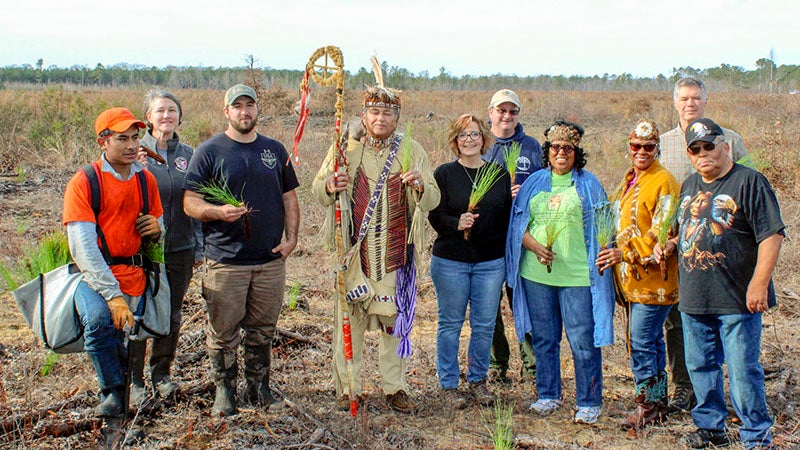Longleaf pines planted on tribal ground
Published 10:21 am Monday, January 7, 2019

- Holding longleaf pine saplings are, at center are Walt Brown, chief of the Cheroenhaka (Nottoway) Indian Tribe, with Rebecca Wilson, Regional Supervisor/Longleaf Pine Restoration specialist. With them at left are an unidentified worker; Michelle Stoll, public information officer of the state Department of Forestry; and Austin Slayton, planting contractor. At right are Darren Loomis, southeast region steward; tribal member Mary Wilkerson; tribal and board member Beverly El; Bobby Clontz of the nature conservancy; and Ellis Wright, vice chief. They participated in a ceremony on Dec. 30 before thousands of the saplings were planted starting that weekend. -- Stephen H. Cowles | Tidewater News
COURTLAND
Beginning late morning of Dec. 30, a brief ceremony commemorated the imminent planting of thousands of longleaf pine saplings. Both were done on tribal land belong to the Cheroenhaka (Nottoway) Indians, and four of its members led in the dedication.
Chief Walt “Red Hawk” Brown, Vice Chief Ellis Wright, and tribal members Mary Wilkerson and Beverly El, also a board member, led that ceremony.
The planting comes nearly a month after the state’s Department of Conservation and Recreation did a controlled burn of 175 acres of land in the area, just south of U.S. Route 58 (Southampton Parkway) near the highway’s intersection with Route 58 business (Camp Parkway.)
Burning cleared the area of debris left from the harvesting for timber a couple of years ago, and makes it suitable for planting the longleaf pines. All that has been part of the years-long mission by the DCR and Virginia Dept. of Forestry, among other state agencies, to restore longleaf populations in the Western Tidewater area.
Before settlers came from Europe, long leaf pines could be found growing on a million acres in the southeastern United States. But as the population grew, the acreage only decreased because people cut down the trees for multiple purposes such as timber for building houses and ships. Gum turpentine could be made from the resin, and the needles could be made into mulch.
Darren Loomis, the southeast region steward for the National Heritage division of the Department of Conservation and Recreation, said that by 2000, there were 300 left. Brown said later that at the completion of planting, there will be a total of 96,000 longleaf pines growing on the tribal land. Previously, 25,600 were put into approximately 63 other acres.
Also present at the ceremony was Rebecca Wilson, DCR regional supervisor, longleaf pine restoration specialist and Eastern fire manager. She said another burning will take place in a year and thereafter one to two years depending on the size of the plants.
The Cheroenhaka tract, as she called it, is part of the DCR’s Recreation’s Cypress Bridge Swamp Natural Area Preserve, which is managed by the Division of Natural Heritage in cooperation with the tribe.
Other locations for such nurseries are in the South Quay area of Suffolk; Zuni and the Chubb Sand Hill in Sussex County.
Wilson and Loomis stressed that the burnings are part of the adaptation process.
“It’s all about competition,” they said. “Otherwise, loblolly pine would take over.”
She said that longleaf pines, which grow from the tops of their heads, will begin to reproduce cones a little in their 20s, and will be considered mature in 80 to 100 years. They could live up to 400 years.





